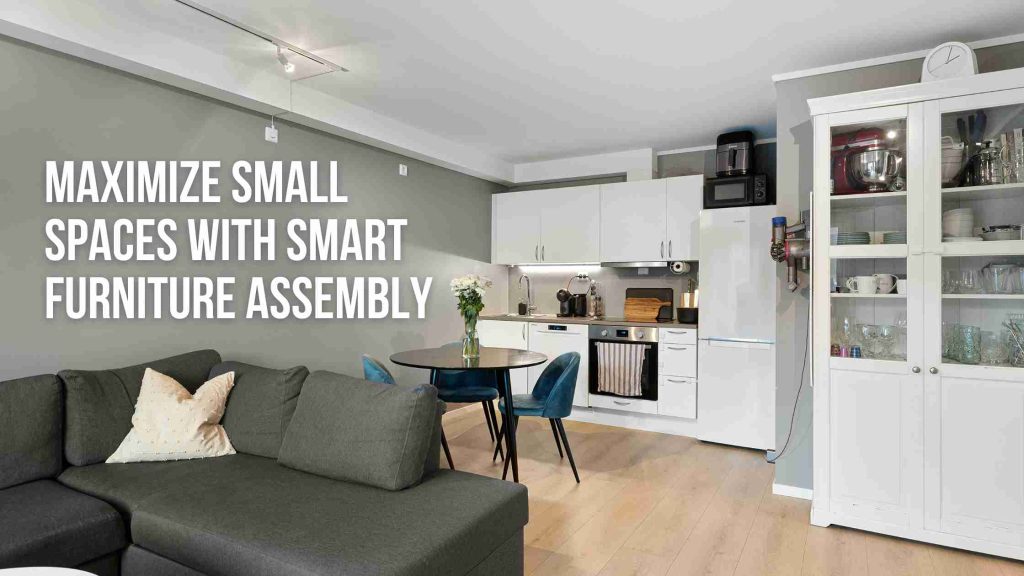Living in a small home or apartment doesn’t mean you have to sacrifice comfort or style. With the right approach to furniture selection and setup, even the tiniest spaces can be functional, beautiful, and clutter-free. The key lies in choosing smart designs and assembling each piece with intention.
Whether you’re furnishing a studio apartment, a guest room, or just trying to make more space in a crowded home, this guide covers everything you need to know about making the most of your square footage. From small room furniture setup tips to assembly best practices and layout hacks, let’s unlock your home’s full potential.
Choosing Furniture for Tight Spaces
The foundation of any space-saving strategy starts with the right furniture. In small rooms, oversized or poorly chosen items can dominate the area, making it feel cramped and chaotic. But smart selection changes everything.
1. Measure First, Shop Second
Always start by measuring your available space before browsing furniture. Be sure to include dimensions for walls, windows, doorways, and walkways. This prevents you from falling in love with a piece that won’t fit or that restricts movement.
Measure not just floor space, but vertical clearance too—tall shelving or wall-mounted storage can offer solutions where floor space is limited.
2. Look for Multi-Functional Pieces
When it comes to space-saving furniture ideas, dual-purpose items are essential. Consider these examples:
- Sofa beds that convert into sleeping areas
- Ottomans with hidden storage
- Wall-mounted desks that fold away
- Dining tables with extendable leaves
These kinds of furniture not only reduce clutter but also adapt to different uses throughout the day.
3. Choose Lightweight and Minimalist Designs
Chunky furniture with thick legs and heavy bases tends to overwhelm small spaces. Opt for open-leg frames, glass tops, or floating designs that give the illusion of more space. Neutral or lighter colors also make rooms feel more airy and open.
4. Go Vertical When Possible
If you can’t expand outward, go up. Tall bookcases, mounted shelves, and hanging organizers take advantage of vertical real estate. These options free up floor space while still offering storage and function.
When planning a small room furniture setup, always think in layers—from the floor to the ceiling—and use every inch with purpose.
Assembling Compact Items Correctly
Once you’ve chosen the right pieces, assembly is the next step—and it matters more than you might think. Incorrect or sloppy assembly can compromise both the look and function of your furniture, especially in tight spaces where every inch counts.
1. Read the Instructions Fully
While it may be tempting to skip ahead, carefully reading the instructions before you begin helps avoid costly mistakes or the need to disassemble later. Take inventory of all parts and hardware before starting to ensure nothing is missing.
2. Assemble in the Room Where the Item Will Live
Large pieces like bed frames, bookshelves, or desks should be assembled in the room where they’ll be used. Attempting to move them through narrow hallways or stairwells after assembly can cause damage or require full disassembly and rework.
3. Use the Right Tools and Hardware
Make sure you have the proper tools—usually a screwdriver, Allen wrench, and possibly a drill with adjustable torque settings. Don’t over-tighten screws, especially on particleboard or MDF materials, which are common in space-saving furniture ideas.
If the item includes wall anchors or safety straps (as many tall items do), take the extra time to install them. This is especially important in homes with pets or children.
4. Don’t Rush the Process
Small furniture often has a more compact design with precision fittings. Rushing through setup can lead to misalignment, squeaks, or even structural issues down the road. If you’re unsure or working alone, it’s worth seeking professional help to ensure a safe and clean build.
Proper assembly is also critical to achieving a smart furniture layout, since even small miscalculations in spacing or height can affect how a room functions and flows.
Optimize Every Corner
After your furniture is in place, the final step is all about maximizing the efficiency and comfort of your space. Layout choices, storage tricks, and thoughtful styling make the difference between a cramped room and a functional retreat.
1. Create Functional Zones
Even in a studio apartment, defining zones for sleeping, working, and relaxing makes the space feel larger and more organized. Use rugs, lighting, or furniture arrangement to separate areas visually without using bulky dividers.
For example, position a desk behind a couch to create a workspace, or use a tall bookshelf as a subtle room divider.
2. Use Corners Strategically
Most people ignore corners, but they’re prime real estate in a small room furniture setup. Install floating corner shelves, place a triangular desk or table, or tuck a slim armchair into a corner nook.
Some modular furniture pieces are designed specifically to fit corners, making them perfect additions to compact spaces.
3. Mirror Magic
Strategically placed mirrors reflect light and create the illusion of more space. A large wall mirror opposite a window can dramatically brighten and open up the room.
Try integrating a mirrored wardrobe or cabinet for added function and style.
4. Keep It Clutter-Free
In a small space, less is truly more. Maximize what you have by decluttering regularly and storing items out of sight. Decorative bins, under-bed storage, and vertical hooks help maintain order without crowding the room.
When implementing a smart furniture layout, always leave enough breathing room around major pieces to allow for natural movement and a more open feel.
Final Thoughts
Furnishing a small space doesn’t mean settling for less—it means being more intentional. With the right furniture choices, proper assembly, and thoughtful layout, your room can feel bigger, brighter, and more functional than ever.
By focusing on space-saving furniture ideas, investing time in accurate assembly, and optimizing every square foot, you’ll transform even the smallest rooms into comfortable and stylish havens.When in doubt, consider working with a local assembly expert to ensure your pieces are built properly and efficiently. A professional touch can make your small room furniture setup not only easier but safer and more polished.



